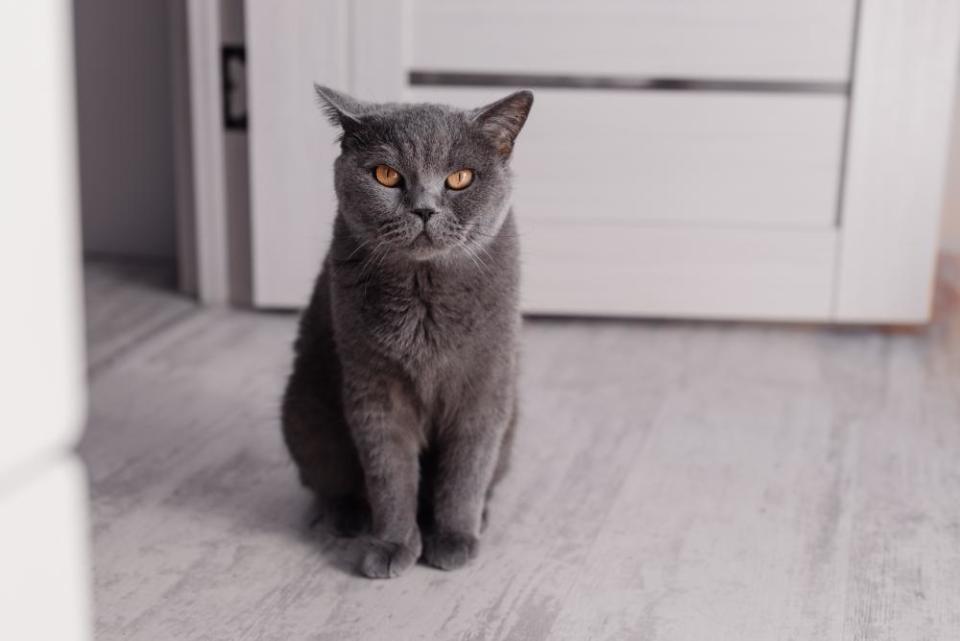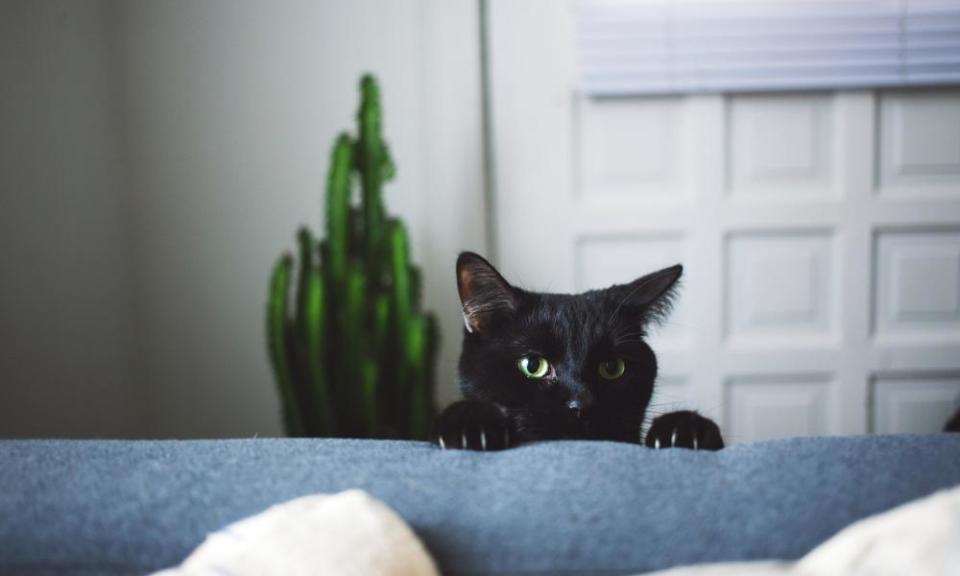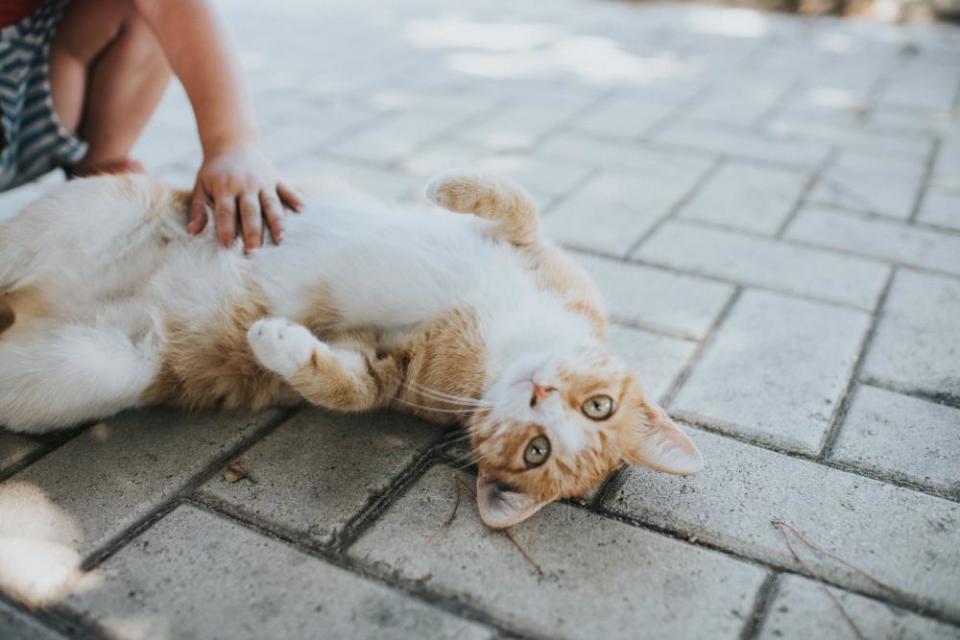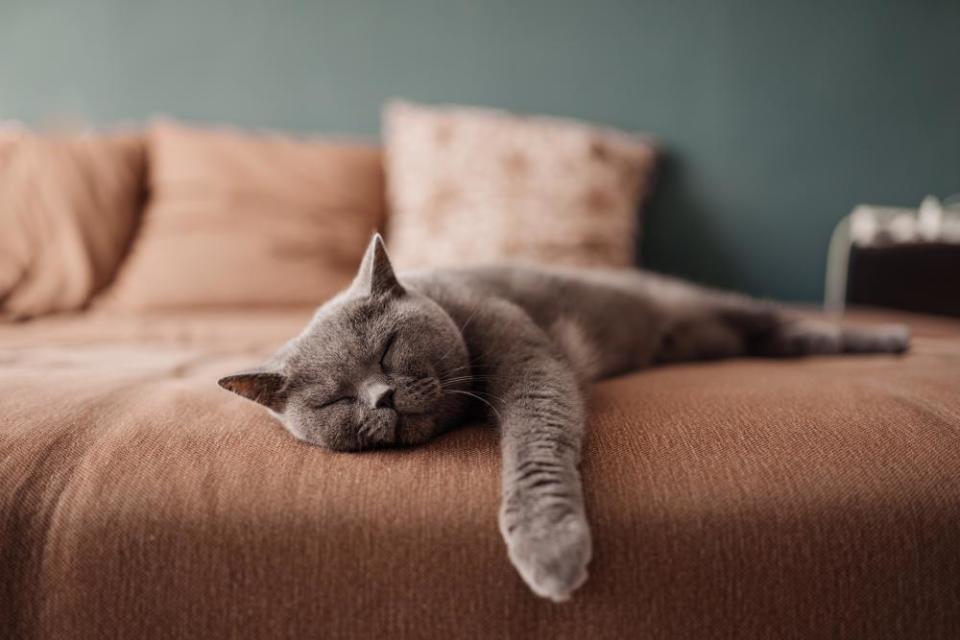The inner lives of cats: what our feline friends really think about hugs, happiness and humans
I wanted to know the exact amount of time I spend ruminating on the inner lives of my cats, so I did what most people do in times of doubt, and consulted Google. According to my search history, in the two years since I became a cat owner I have Googled variations of “cat love me – how do I tell?” and “is my cat happy 17 times. I have also inadvertently subscribed to cat-related updates from the knowledge website Quora, which emails me a daily digest. (Sample: Can Cats Be Angry or Disappointed With Their Owner?)
Related: Cats track their owners’ movements, research finds
How do I love my cats? Let me count the ways. The clean snap of three-year-old Larry’s jaw as he contemplates me with detached curiosity is my favourite sound in the world. I love the tenor and cadence of my six-month-old kitten Kedi’s miaows as he follows me around the house. (High-pitched indignant squeaks means he wants food; lower-pitched chirrups suggest he would like to play.) I love the weight of Larry on my feet at night and the scratchy caress of Kedi’s tongue on my eyelid in the morning.
But how do I know what these little tykes really think and feel? I fear the authors of online listicles written in cursive fonts are unlikely to provide me with the latest scientific research – and are probably just saying what they think I want to hear. To truly journey into the feline soul, I will have to go to the fountainhead.

Despite the fact that cats are the most common pet in UK households after dogs, we know relatively little about them. This, says Dr Carlo Siracusa of the University of Pennsylvania School of Veterinary Medicine, “is partly due to practical problems.”
Dogs are easy to study: you can take them to a lab and they will be content. But cats are intensely territorial creatures. “The behaviour of a cat is so modified by its environment that if you move it to a laboratory,” says Siracusa, “what you’ll see is not really reflective of what the normal behaviour of the cat is.”
I was attracted by their mysteriousness. What are these cats thinking? How do they perceive the world?
Dr Saho Takagi
But there is another reason that cats are under-researched. “There’s a stigma,” says Siracusa. Cats have been unfairly maligned through much of human history. In the middle ages, cats were thought of as the companions of witches, and sometimes tortured and burned. “They have been stigmatised as evil because they are thought to be amoral,” says the philosopher and writer John Gray, author of Feline Philosophy: Cats and the Meaning of Life. “Which in a sense, cats are – they just want to follow their own nature.”
What we do know about the inner lives of domestic cats is usually determined by scientists running studies in their homes. Unsurprisingly, many of these scientists are cat owners. “Of course I am a cat lover,” says Dr Saho Takagi of Kyoto University. “When I started raising cats, I was attracted by their mysteriousness. What are these cats thinking? How do they perceive the world? These are the questions that motivate me in my research.” Takagi is holding a cat in her photo on the professional network for scientists, ResearchGate.
She co-authored a paper, published last month, that found that cats mentally track the locations of their owners by their voice, even when they can’t see them. Cats participating in the study were played audio of their owners calling their names. When the source of their owner’s voice moved, they appeared the most startled. “These findings suggest that cats are quite concerned about their owners,” she says. “They may be watching their owner’s every action carefully, thinking about what will happen next.”
Cats do get attached to people. They show affection by being in the same room as you or physically close to you
Dr Carlo Siracusa
A common criticism levelled at cats is that these capricious little creatures only use humans for warm beds and a reliable source of protein. But “cats do get attached to people,” says Siracusa. “They get attached to other animals too.” He explains that cats often show affection by proximity, if not physical interaction, “being in the same room as you or physically close to you”. More demonstrative cats will sleep on or near their owners, or other cats. “Cats who have grown up together are more likely to be preferred associates,” he says. “But as a general rule cats do not like to be picked up, hugged and kissed. The great majority of cats don’t like this.”

This misapprehension that cats do not care for their owners typically comes from humans who are disappointed their cats don’t behave like other humans, or at the very least, dogs. “Cats are not people,” Siracusa sighs, “and they are not dogs. Humans hug and kiss. Dogs become very excited and jump around. Cats don’t do anything like that. They are much more elegant. They approach us. They bump their heads. Then they have some contact with us and walk away.”
This is because they are descended from the African wildcat, a solitary creature. “Cats are not social,” says clinical veterinarian Karen Hiestand of the University of Sussex. “They do not need friends.” Although, in multicat households, cats may choose to exhibit affection by allogrooming – licking each other. Watching Larry and Kedi groom each other is usually the highlight of my day.
Cats can feel depressed, says Hiestand. Just don’t call it depression. “There are issues around using mental health terminology on non-human species,” she says. “I have my own views: if it looks like a horse and sounds like a horse, then call it a horse.” The issue when it comes to spotting depressed cats, Hiestand says, “is that cat behaviour is incredibly subtle. We don’t notice when cats are miserable because a miserable cat sits still and doesn’t do much. We think that, if they are miserable, they’ll be hissing and fighting. But that’s an action of last resort for them. There’s a world of misery before then. We just don’t notice.” Changes in behaviour can be a sign of cat distress: when Siracusa started working from home due to the pandemic, his cat, Elsa, was disoriented and upset by the unexpected change in his behaviour. (Look out for changes in their toilet habits, or food consumption.) Fascinatingly, when Siracusa put Elsa on probiotics, this appeared to improve her mood. “Behavioural disorders are influenced by the immune system, and the immune system is influenced by the gut,” he says.

Cats also retain memories: I have seen this myself first-hand. When Larry burned his paw on my induction hob last year, he stopped walking on my kitchen units for months. If I picked him up and placed him on the worktop, he would jump off, associating the area with the memory of pain. “Memories related to emotions,” explains Siracusa, “and memories that cause a negative feeling are particularly good for our survival. Cats learn from experience and retain information that will keep them away from trouble or help them to get an advantage.”
Cats retain more prosaic memories too. Takagi has conducted experiments in which cats are fed using multiple bowls of food over a period of time. The researchers learned which types of food the cats liked best and served it in a specific bowl (allowing them to create memories of what was served and when), then later switched the bowls. They found that the cats could recall if they had previously searched a given bowl when looking for a particular treat and the circumstances under which this had occurred. “This showed that it was a one-time experience that could be used and retrieved later,” says Takagi. “This type of memory is called episodic memory, and it is equivalent to memories in humans.”
Sometimes you see their feet pedalling as if they are running in their dreams … it’s not so dissimilar to the human experience
Karen Hiestand
They even dream. “In practice,” says Hiestand, “there are some anaesthetic agents we use when operating on cats that are hallucinogenic. I always think, what is the cat hallucinating? Is it giant mice? Sometimes, you see their feet pedalling, as if they are running in their dreams.” She believes these dreams aren’t so dissimilar to the human experience of dreaming: “Going over the day’s events and storing things in their memory banks,” Hiestand says. “There’s no reason to think their brains would work so differently to ours in that respect.”

What cats cannot do, however, is project into the future, because their frontal lobes are not developed. “Cats can’t make long-term plans,” says Siracusa. “Some people think that [when] they leave the house, and their cat poops on the couch, it is so that when I return I have a nasty experience. But cats do not have the ability to plan ahead in this way.” That means Kedi isn’t trying to annoy me when he knocks over my laundry rack: he can’t conceptualise that I may respond negatively to seeing fresh laundry strewn across the floor.
So what is going on in those catty little brains? “That’s a difficult question,” Siracusa says. “I think most of their thoughts are about how to stay safe. Stay away from predators. Do cool stuff, such as eat a juicy mouse. Because they live in a human world, they most likely have thoughts related to us. That new tumble dryer we bought makes a terrible noise. But most of their thoughts are related to staying safe, and happy.” He pauses, and then laughs: “But I suppose those are my inner thoughts, projected on to a cat’s inner thoughts.”
Over the course of the week it takes me to research and write this article, I become obsessed – even more than before – with the happiness and wellbeing of my charges. I observe their pointy little faces carefully, watchful for any flicker of emotion behind their translucent amber eyes. I even send videos of them to the cat behaviourist Anita Kelsey, author of Let’s Talk About Cats. “He’s excited to see you,” she says in response to one video of Kedi accosting me in the morning. “He knows his food is coming soon. There’s a burst of energy shortly after waking. It’s typical behaviour.”

It isn’t enough. Sure, I can see what they are doing in front of me: licking their bottoms, jumping at flies, sleeping adorably on their backs, fluffy bellies crying out to be tickled. But the lives they lead when I’m not around remain a mystery. Do they pine for me, or are they unmoved? The answer, of course, is to spy on them. The home security company, Canary, provides me with motion-activated internal security cameras. What do they reveal? The cats flick pens off my desk. They rip chunks out of my overpriced ergonomic office chair. They drink out of abandoned water glasses. They exist blithely, unconcernedly, unbothered by my physical absence.
Cats are themselves, and they stay themselves. They adapt to human ways. But they don’t adopt human ways
John Gray
Most cats do not long for their absent owners any more than they will fetch a ball on command, or embrace veganism. They are cats. They do what they want, all the time. “Cats are a window outside the human world,” says Gray, “They are themselves, and they stay themselves. They adapt to human ways. But they don’t adopt human ways.”
In other words, we should stop trying to project human attributes on to these inscrutable creatures. “Cats are cats and humans are humans and we can’t become cats,” Gray says. “I think the question should really be, can we learn anything from them that is beneficial to us? I think we can. By looking at something so different to us, that lives alongside us, we can shake the more harmful habits that go with being human. Such as worrying about the future and not living enough in the present, or being content with the life we have.” Also, sleeping a lot.

It strikes me, speaking to Gray, that the ancient Egyptians got it right. They worshipped cats: their deity Mut, the mother goddess, was frequently depicted as a cat. “It’s because they are so self-possessed and imperious,” says Gray. “They do what they want to do. And live the way they want to live.” Perhaps a better relationship between human and cat would approximate these ancient ways. After all, you don’t need to understand the ways of a cat to worship it.
My week-long journey into the feline soul ends with me unplugging my cameras and returning Larry and Kedi to an unmonitored existence. Before I do, I fire up the camera and watch the footage one last time. I see a little kitten, reaching its paw toward the all-seeing eye of a technological interloper. And me, behind the camera, striving for the felicity that comes to our feline friends so easily.

